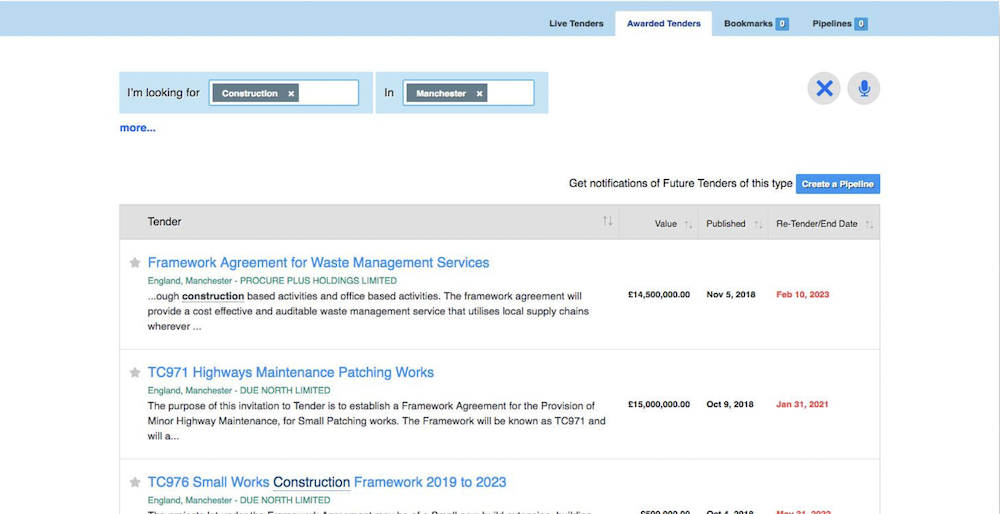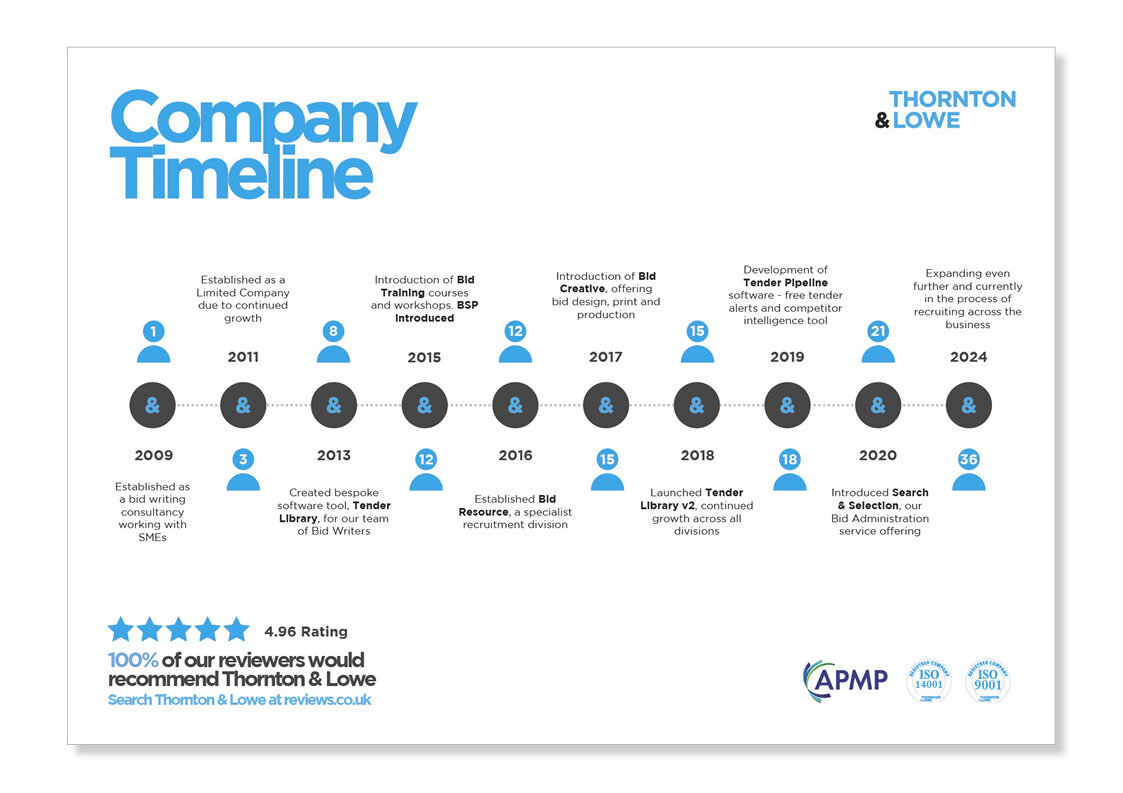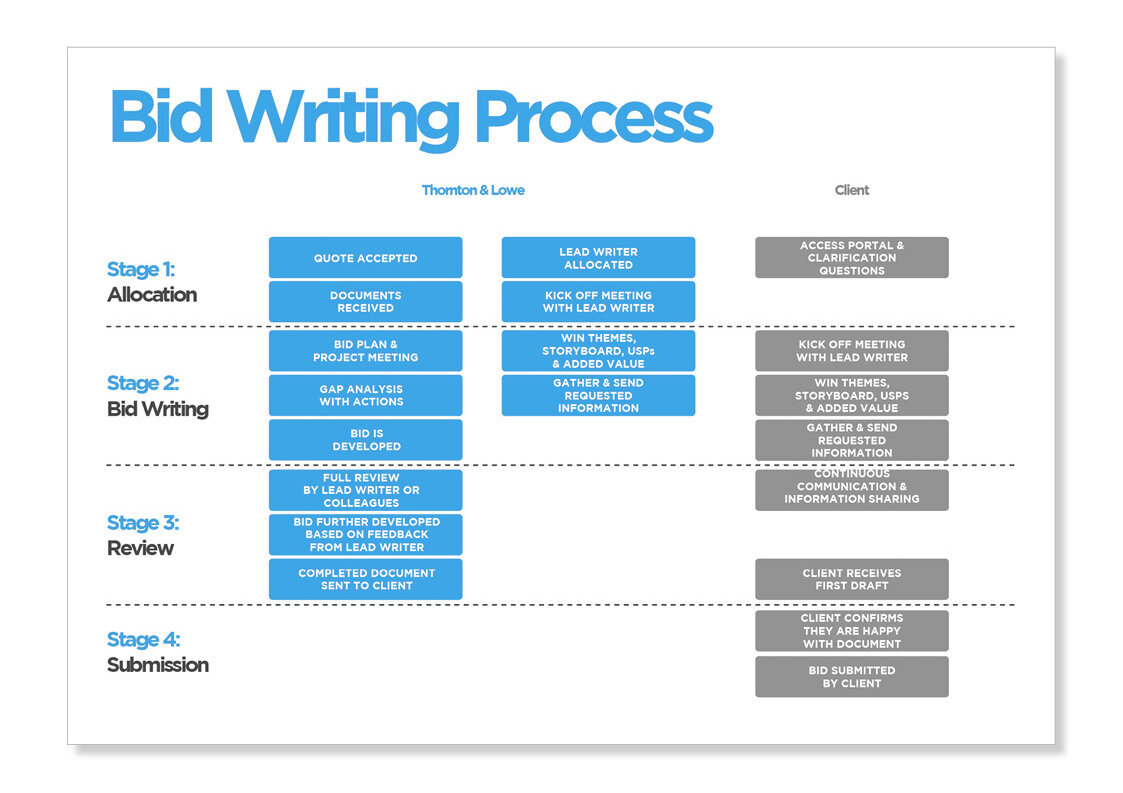The tendering process, which involves bidding for tender documents, framework agreements, and the chance to bid on government contracts, requires time and effort. Well... that's not 'easy'! No, but over the last 15 years we have developed a suite of tender writing services to allow our clients to easily bid for tenders. Or at least more easily!
Whether it's tender bidding, bid writing, or navigating through the various tender process steps, each stage comes with its own set of challenges and requirements. Our services are designed to minimise disruption for our clients. Thornton & Lowe provides:
- Tender alerts and monitoring.
- Portal management.
- Bid administration and coordination.
- Bid writing and bid management.
- Bid design services.
- Bid submission support.
- A route for 'lessons learned' and continuous improvement.
- Advice on procurement and bidders right to challenge.
- Social Value responses and data collation.
- Carbon Reduction Plans and data collation.
We do not price or do the commercials of your bid, however we have built a solution for everything else.
You may find the following useful:
- The cost of outsourcing bid writing.
- Tender subscription services and prices.
See our 4 steps below to help you easily bid for tenders!
What is a bid writer?
Read moreStep 1: Finding Relevant Tenders
Identifying Opportunities
To begin, we must explore the digital landscape where most tender opportunities are now presented. Tender portals simplify the procurement process by consolidating all necessary actions, such as expressing interest, downloading documents, and submitting queries and bids into a single online platform (per tender). The key portal for government tenders in the UK is Find a Tender. Tender Pipeline is our free tender alert service, making it easier for you to find tenders and understand the competition.
Evaluating Suitability
Before diving into the bidding process, it’s important to assess whether a tender is a good fit for your company. This involves understanding our capabilities and limitations to avoid pursuing unsuitable contracts.
It's important to consider the key risks and opportunities, which a tender presents. We deliver this is an outsourced bid service via Search & Select. Helping you easily bid for tenders!

Step 2: Preparing the Bid
Required Documents
To ensure a comprehensive bid, we must gather all necessary documentation as outlined in the Invitation to Tender (ITT). This includes a detailed list of requirements such as the project's scope, timelines, evaluation criteria, and specific terms and conditions. It's essential that we review these documents to understand the client's needs fully and tailor our bid accordingly.
We offer this as part of our Bid Administration Service and Bid Success Programme.
Crafting Responses
Storyboarding is a powerful tool we employ to structure our responses effectively. By pre-planning our answers, we ensure that each response is clear, concise, and directly addresses the tender's requirements. We focus on highlighting our strengths and how they align with the goals of the project, ensuring that our bid is compelling and competitive. This method allows us to present a coherent narrative that not only meets but exceeds the expectations of the tender panel.
Building Your Bid Team
The success of your bid heavily relies on the expertise and collaboration of your team. Early in the bid process, you need to identify and assemble a group of specialists, each bringing a unique set of skills and experiences relevant to the tender's demands. This team includes Bid Managers, Subject Matter Experts, and Bid Writers, all coordinated by a Proposal Manager, for example. Together, they use collective knowledge to craft a bid that demonstrates our proficiency and readiness to deliver exceptional results.
If you do not outsource your bids and want to recruit your own bid team, Thornton & Lowe can help. Our Bid Resource division, focuses on recruiting bid writers and bid managers. With a skills shortage in the bid professional we can recruit, train and mentor trainee bid writers for your business. We have a bid management function around for them control, assurance, added value and continuity.

Step 3: Writing the Proposal
Addressing the tender requirements when writing a proposal is of course important. This means ensuring you clearly answer each element of the question and sub-questions within it. Referring back to the requirements and relevant elements of the tender specification. In addition, including any win themes or key reasons why you are the most suitable supplier. The other key addition being the use of the marking scheme or scoring criteria, which details how your quality tender answers will be evaluated.
You should recognise evidence as a key tool in meeting these marking schemes. This includes showcasing relevant case studies and testimonials that demonstrate our previous success and expertise in similar projects. Ensuring all case studies are recent and relevant, reflecting your capabilities and aligning closely with the tender's requirements.
Bid Formatting Tips: Our approach to formatting the proposal is strategic, enhancing readability and impact. We adhere to the tender instructions regarding document format, which often specifies the use of Arial font size 11. We incorporate elements such as diagrams, pictures, and organisational charts where permitted, as these do not count towards the response word count but significantly aid in conveying our message effectively. We use headings, subheadings, bullet points, and tables to organise content clearly and make key points stand out. Additionally, we ensure that the final document is saved in the required format, often as a PDF, to maintain the integrity and formatting of the proposal.

Step 4: Submission and Follow-Up
How to Submit
When you approach the submission of your tender, it's crucial that you meticulously follow the guidelines provided in the Invitation to Tender (ITT). Ensuring every document is formatted according to the specified requirements, often needing Arial font size 11 and PDF format for digital submissions. You should double-check that all sections are complete, with supporting materials correctly referenced and included in the appendix. Before final submission, a thorough bid review will catch any oversights and to confirm clarity throughout the document. Additionally, ensuring all necessary signatures, particularly 'wet signatures' where required, are in place is vital for the validity of our submission.
Post-Submission Checklist
Post-submission, maintaining an organised approach is essential. We keep a duplicate copy of the tender documents for our records. Monitoring all communication channels is critical, as the buyer may contact us with follow-up questions or require clarifications on our submission. We prepare to respond promptly within any given deadlines to avoid jeopardising our chances. If invited for further presentations or interviews, we ready ourselves to provide comprehensive and well-structured responses, ensuring we cover all preset questions effectively.
Responding to Feedback
Regardless of the outcome, actively seeking and responding to feedback is a fundamental step in our continuous improvement. If successful, we analyse the feedback to identify strengths to emphasise in future bids. In cases where our bid was not selected, we request detailed feedback to understand the areas needing enhancement. This feedback is invaluable for refining our tendering strategy and improving our submissions for future opportunities. We view each piece of feedback as a chance to evolve, ensuring our next tender is stronger and more aligned with the buyer's expectations.
Prefer to discuss?
Contact usBidding for Tenders - FAQs
What are the key steps involved in the bidding process?
There are five essential steps to follow when bidding for a contract:
- Identify the most suitable bid for your business.
- Engage in thorough planning and research.
- Ensure your pricing strategy is competitive.
- Craft a compelling and high-quality bid response.
- Finally, submit your bid.
What is the one action which we can do to more easily bid for tenders?
Preparation. Develop bid libraries, bid templates and systems to make your life easier. Anytime you can save can be reinvested into the 'good stuff' of tailoring, adding value and making sure your bid is as persuasive as possible.
How should one go about preparing a tender?
Preparing a tender involves several critical steps:
- Commence with a detailed planning process.
- Define clear procurement objectives.
- Develop a strategy for market engagement.
- Outline the tender strategy including key dates and timelines.
- Establish a robust tender evaluation process.
- Ensure proper management of probity and contract management.
- Set up effective governance and allocate resources accordingly.
How is a bid strategy formulated?
Creating a bid strategy involves several strategic steps:
- Define clear objectives for the bid to guide all actions.
- Conduct research, understand competition levels and cost implications.
- Your bid strategy should be based around maximising your return on investment from bidding.
How do I find local bid support?
We can help - contact us - but we also have a specific article to guide you on this - 'bid writers near me'.




